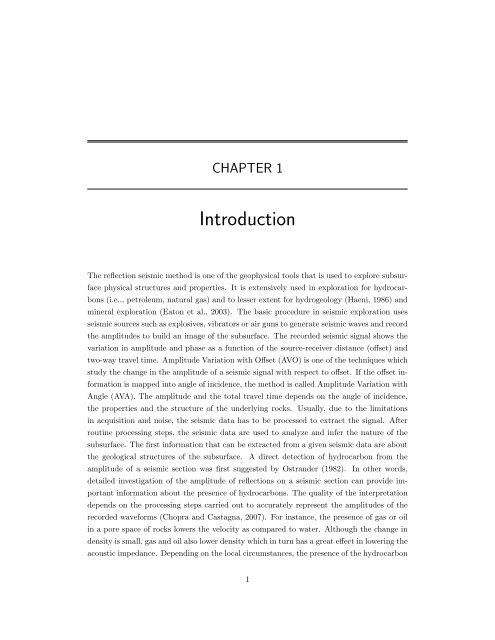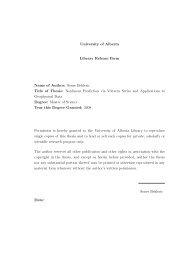Regularization of the AVO inverse problem by means of a ...
Regularization of the AVO inverse problem by means of a ...
Regularization of the AVO inverse problem by means of a ...
Create successful ePaper yourself
Turn your PDF publications into a flip-book with our unique Google optimized e-Paper software.
CHAPTER 1<br />
Introduction<br />
The reflection seismic method is one <strong>of</strong> <strong>the</strong> geophysical tools that is used to explore subsur-<br />
face physical structures and properties. It is extensively used in exploration for hydrocar-<br />
bons (i.e.., petroleum, natural gas) and to lesser extent for hydrogeology (Haeni, 1986) and<br />
mineral exploration (Eaton et al., 2003). The basic procedure in seismic exploration uses<br />
seismic sources such as explosives, vibrators or air guns to generate seismic waves and record<br />
<strong>the</strong> amplitudes to build an image <strong>of</strong> <strong>the</strong> subsurface. The recorded seismic signal shows <strong>the</strong><br />
variation in amplitude and phase as a function <strong>of</strong> <strong>the</strong> source-receiver distance (<strong>of</strong>fset) and<br />
two-way travel time. Amplitude Variation with Offset (<strong>AVO</strong>) is one <strong>of</strong> <strong>the</strong> techniques which<br />
study <strong>the</strong> change in <strong>the</strong> amplitude <strong>of</strong> a seismic signal with respect to <strong>of</strong>fset. If <strong>the</strong> <strong>of</strong>fset in-<br />
formation is mapped into angle <strong>of</strong> incidence, <strong>the</strong> method is called Amplitude Variation with<br />
Angle (AVA). The amplitude and <strong>the</strong> total travel time depends on <strong>the</strong> angle <strong>of</strong> incidence,<br />
<strong>the</strong> properties and <strong>the</strong> structure <strong>of</strong> <strong>the</strong> underlying rocks. Usually, due to <strong>the</strong> limitations<br />
in acquisition and noise, <strong>the</strong> seismic data has to be processed to extract <strong>the</strong> signal. After<br />
routine processing steps, <strong>the</strong> seismic data are used to analyze and infer <strong>the</strong> nature <strong>of</strong> <strong>the</strong><br />
subsurface. The first information that can be extracted from a given seismic data are about<br />
<strong>the</strong> geological structures <strong>of</strong> <strong>the</strong> subsurface. A direct detection <strong>of</strong> hydrocarbon from <strong>the</strong><br />
amplitude <strong>of</strong> a seismic section was first suggested <strong>by</strong> Ostrander (1982). In o<strong>the</strong>r words,<br />
detailed investigation <strong>of</strong> <strong>the</strong> amplitude <strong>of</strong> reflections on a seismic section can provide im-<br />
portant information about <strong>the</strong> presence <strong>of</strong> hydrocarbons. The quality <strong>of</strong> <strong>the</strong> interpretation<br />
depends on <strong>the</strong> processing steps carried out to accurately represent <strong>the</strong> amplitudes <strong>of</strong> <strong>the</strong><br />
recorded waveforms (Chopra and Castagna, 2007). For instance, <strong>the</strong> presence <strong>of</strong> gas or oil<br />
in a pore space <strong>of</strong> rocks lowers <strong>the</strong> velocity as compared to water. Although <strong>the</strong> change in<br />
density is small, gas and oil also lower density which in turn has a great effect in lowering <strong>the</strong><br />
acoustic impedance. Depending on <strong>the</strong> local circumstances, <strong>the</strong> presence <strong>of</strong> <strong>the</strong> hydrocarbon<br />
1









